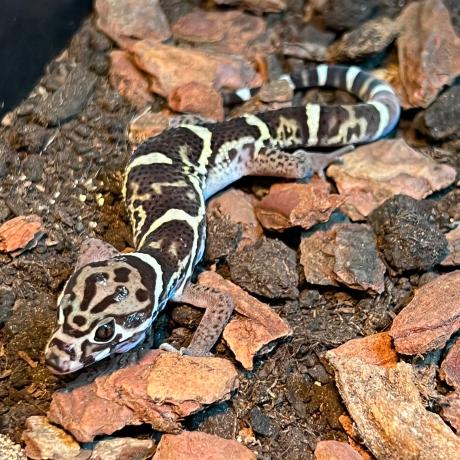

This small pretty gecko is native to Central America. But whilst thousands of miles apart, this species is actually closely related to the Leopard gecko.
| Origin | Central America |
|---|---|
| Environment | Semi arid and Humid forests |
| Adult Size | Up to 12cm |
| Suitability | Beginner |
| Lifespan | 8 Years + |
| Temperment | Skittish |
These animals can be compared with the popular leopard geckos in colours and patterns, though this species has a more lean appearance and their tails are more slim. The adults tend not to exceed 12cm.
Central American Banded Geckos have an erratic cream/yellow coloured banding that goes along the length of the body, head and tail the base colour is generally dark brown. These geckos generally have a white/cream underbelly.
Central American Banded Geckos (Coleonyx mitratus) originate from Central America. They inhabit both semi-arid and humid forest regions . These animals are crepuscular and would take refuge during the day in underground burrows, under rocks or in hollow wood.
Central American Banded geckos can be housed in enclosures either alone or within a sexed group. Females can be housed with a single male in larger vivariums, however you must carefully monitor each animal and ensure that they remain happy and stress free. Unless you intend to breed your animals tt is advisable not to keep males with females. We would advise to house your animals singular in most cases with a minimum floor space of 30” x 12".
For substrate we would advise using a fine orchid bark, coir or sandy/soil mix. These geckos are fairly shy and it is important to provide them with plenty of environmental enrichment by way of adding hides, plants and shelters. They require moderate humidity levels of 50-60% and in addition, a humidifying shelter is recommended. When this is provided it will allow them to select the substrate moisture and humidity level they require.
For heating temperatures can be maintained by using a basking lamp with a guard. All heat sources should be thermostatically controlled to avoid risk of overheating.
The aim is to provide a basking spot that maintains at 32°C, with it dropping no cooler than 25°C throughout the rest of the vivarium. This allows the reptile to thermoregulate efficiently. A nighttime temperature drop of 5°C is advised and a good quality thermostat and digital thermometer will help you achieve this. We recommend using a low level UVB light. Recent studies have shown that the skin of some geckos is twenty times more absorbent than that of a bearded dragon. After all, they are crepuscular and whilst limited, they would have some natural exposure to sunlight in the wild. Providing 12 hours of UVB light will also help simulate a natural daylight cycle and will aid calcium absorption via access to natural D3. With this in mind, it can only be beneficial to your gecko with access to UVB.
When feeding you should remember that Central American Banded Geckos are insectivores. This makes their care relatively simple as they can be provided with a varied diet which is commercially available. We generally feed our geckos on a diet of crickets, mealworms and we also give them the occasional locusts.
Like with all lizards, you must use a good quality dusting powder to provide essential calcium and vitamins to your gecko. This compensates for eating a less varied diet than their wild ancestors. The easiest method for coating your livefood is to put a little supplement powder in a zip-lock bag, add the insects and gently shake. Use some forceps to transfer the livefood into your enclosure. This way, you are not wasting your supplements and only dusting the insects needed per feed.
Handling Central American Banded Geckos can be done carefully, they are fairly skittish by nature though they do get used to being handled. Handling must be done close to the floor to begin with, to prevent any accidental falls. Never restrain your animal against its will or it could cause them a great deal of stress and your gecko could also drop its tail as a consequence. It is worth noting also that you should never hold your gecko by its tail.
Sexing your geckos can be done visually once they reach a juvenile age. Males will start to develop pre-anal pores above the vent and hemipene bulges below. Comparing both sexes side by side it becomes very obvious what you are looking for and with further experience you can start to sex them at a younger age.